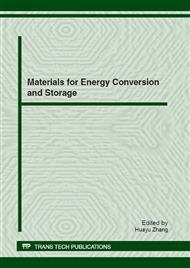p.188
p.193
p.197
p.201
p.206
p.211
p.215
p.220
p.224
Preparation of Graphene-Like Carbon Materials as Electrodes of Electric Double Layer Capacitors
Abstract:
Graphene-like carbon materials (GCMs) are prepared by the carbonization of liquid acrylonitrile oligomer (LANO) at 600-1400 °C for 4 h in an Ar atmosphere. LANO undergoes thermal oxidative dehydrogenation and preliminary cyclization by pre-process in air at low temperature (120 °C) and high temperature (220 °C) before the carbonization. Surface chemistry,crystalline and pore structures of the GCMs are characterized by scanning electron microscope (SEM), power X-ray diffraction (XRD) and N2 adsorption respectively. Comparison of the effect of various carbonization temperatures on the electrochemical performance of the electric double layer capacitors (EDLCs) is specifically investigated. The GCMs carbonized at 1300 °C for 4 h shows a fairly good electrochemical performance. The BET surface area of GCM1300 is 81.58 m2/g and the specific capacitance of the GCM1300 is 22.52 F/g in 1 mol/ L Et4NBF4/PC electrolytes.
Info:
Periodical:
Pages:
206-210
Citation:
Online since:
July 2012
Price:
Сopyright:
© 2012 Trans Tech Publications Ltd. All Rights Reserved
Share:
Citation:



